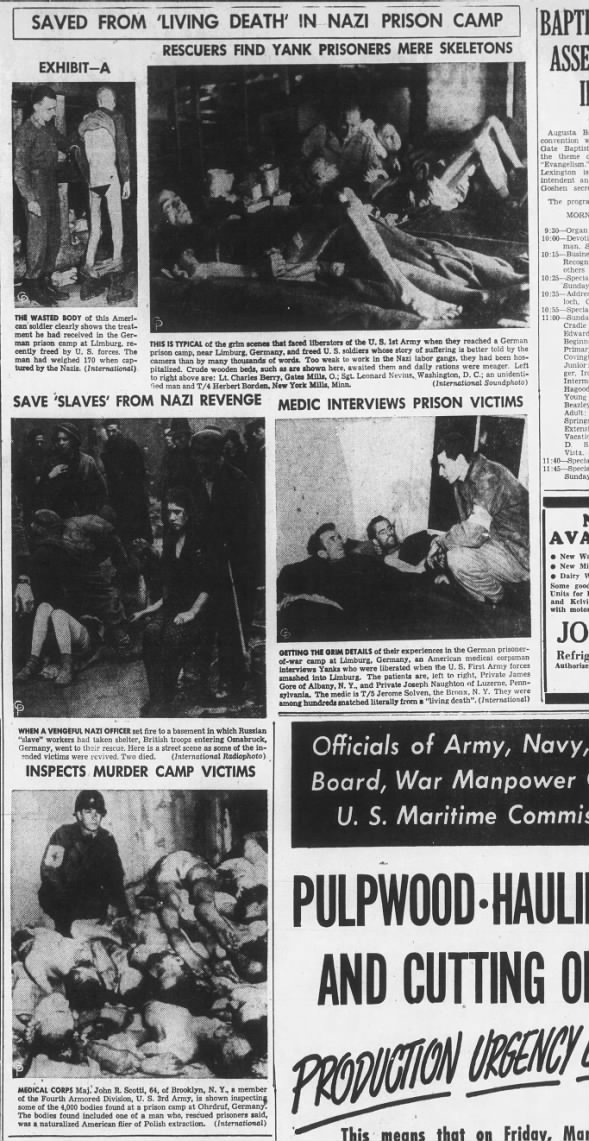- Headline
-
Saved From 'Living Death' In Nazi Prison Camp
- Sub-Headline
- Exhibit-A; Rescuers Find Yank Prisoners Mere Skeletons; Save 'Slaves' From Nazi Revenge; Medic Interviews Prison Victims; Inspects Murder Camp Victims
- Publication Date
- Tuesday, April 10, 1945
- Historical Event
-
Eisenhower Asks Congress and Press to Witness Nazi Horrors
This database includes 1,688 articles about this event - Article Type
- Page Section and Number
- 5
- Author/Byline
- International
- Article Text
- EXHIBIT—A
[CP Image]
THE WASTED BODY of this American soldier clearly shows the treatment he had received in the German prison camp at Limburg, recently freed by U. S. forced. The man had weighed 170 when captured by the Nazis. (International)
RESCUERS FIND YANK PRISONERS MERE SKELETONS
[CP Image]
THIS IS TYPICAL of the grim scenes that faces liberators of the U. S. 1st Army when they reached a German prison camp, near Limburg. Germany, and freed U. S. soldiers whose story of suffering is better told by the camera than by many thousands of words. Too weak to work in the Nazi labor gangs, they had been hospitalized. Crude wooden beds, such as are shown here, awaited them and daily rations were meager. Left to right above are: Lt Charles Berry, Gates Mills, O.; Sgt Leonard Nevius, Washington, D. C; an unidentified man and T/4 Herbert Borden, New York Mills, Minn. (International Soundphoto)
SAVE 'SLAVES' FROM NAZI REVENGE
[CP Image]
WHEN A VENGEFUL NAZI OFFICER set fire to a basement in which Russian "slave" workers had taken shelter, British troops entering Osnabruck, Germany, went to their rescue. Here is a street scene as some of the intended victims were revived. Two died. (International Radiophoto)
MEDIC INTERVIEWS PRISON VICTIMS
[CP Image]
GETTING THE GRIM DETAILS of their experiences in the German prisoner-of-war camp at Limburg, Germany, an American medical corpsman interviews Yanks who were liberated when the U. S. First Army forces smashed into Limburg. The patients are, left to right, Private James Gore of Albany, N. Y and Private Joseph Naughton of Luzerne, Pennsylvania. The medic is T/5 Jerome Solven, the Bronx, N. Y. They were among hundreds snatched literally from a "living death". (International)
INSPECTS MURDER CAMP VICTIMS
[CP Image]
MEDICAL CORPS Maj. John R. Scotti, 64, of Brooklyn, N. Y., a member of the Fourth Armored Division, U. S. 3rd Army, is shown inspecting some of the 4,000 bodies found at a prison camp at Ohrdruf, Germany. The bodies found included one of a man who, rescued prisoners said, was a naturalized American flier of Polish extraction. (International) - History Unfolded Contributor
- Jennifer G.
- Location of Research
- Newspapers.com (https://www.newspapers.com)
Learn More about this Historical Event: Eisenhower Asks Congress and Press to Witness Nazi Horrors
- Ohrdruf (Encyclopedia Article)
- Liberation of Nazi Camps (Encyclopedia Article)
- 4th Armored Division (Encyclopedia Article)
Bibliography
Abzug, Robert H. GIs Remember: Liberating the Concentration Camps. Washington, DC: National Museum of American Jewish History, 1994.
Abzug, Robert H. Inside the Vicious Heart: Americans and the Liberation of Nazi Concentration Camps. New York: Oxford University Press, 1985.
Bridgman, Jon. End of the Holocaust: The Liberation of the Camps. Portland, OR: Areopagitica Press, 1990.
Chamberlin, Brewster S., and Marcia Feldman, editors. The Liberation of the Nazi Concentration Camps 1945: Eyewitness Accounts of the Liberators. Washington, DC: United States Holocaust Memorial Council, 1987.
Goodell, Stephen, and Kevin Mahoney. 1945: The Year of Liberation. Washington, DC: United States Holocaust Memorial Museum, 1995.
Goodell, Stephen, and Susan D. Bachrach. Liberation 1945. Washington, DC: United States Holocaust Memorial Museum, 1995.
All articles about this event
